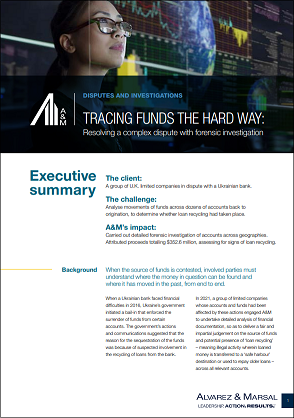Case Study: Tracing Funds the Hard Way
Background
When the source of funds is contested, involved parties must understand where the money in question can be found and where it has moved in the past, from end to end.
When a Ukrainian bank faced financial difficulties in 2016, Ukraine’s government initiated a bail-in that enforced the surrender of funds from certain accounts. The government’s actions and communications suggested that the reason for the sequestration of the funds was because of suspected involvement in the recycling of loans from the bank.
In 2021, a group of limited companies whose accounts and funds had been affected by these actions engaged A&M to undertake detailed analysis of financial documentation, so as to deliver a fair and impartial judgement on the source of funds and potential presence of ‘loan recycling’ – meaning illegal activity wherein loaned money is transferred to a ‘safe harbour’ destination or used to repay older loans – across all relevant accounts.
The process
A&M was presented with a large amount of documentation amounting to thousands of bank statements spanning many years, encompassing multiple geographies, currencies and corporate entities.
A&M set about investigating the subsequent movement of several large payments of funds from the claimants’ accounts, determining whether any movement of money was related to loan recycling. The process meant combing through accounts in granular detail, matching receipts with payments leaving those accounts. Where matching in this way was not possible, the team adopted a ‘First In First Out’ principle to trace amounts back to their first receipt.
A&M sampled segments of the data – identifying particularly large or exceptional purchases as well as picking other tranches at random – for more detailed testing, assessing whether any funds had been used for personal purchases.
In all, the movement of more than $350 million was analysed by A&M, including at least $9.7m of earned interest. A&M was able to determine that no typical signs of loan recycling were evident.
Loan recycling: what to look for
Asking the following questions will help identify whether loan recycling may be a factor in an investigation:
- Is the principal of new loans being used to repay older loans?
- Are proceeds being moved to ‘safe harbour’ destinations?
- Are any loans delinquent?
- Are identities of loan recipients being obscured?
- Are the loans exited quickly, or do they have an unusually short lifecycle?
The A&M difference
Facing restrictions that limited the amount of automation that could be achieved with technology, A&M’s professionals embarked on manual analysis of a large amount of sensitive financial data. Diligence and attention to detail resulted in a successful assessment of salient information to deliver a clear professional opinion to all parties.
A&M’s independence from conflicts of interest and willingness to speak frankly meant that a commercially sensitive process was dealt with fairly and robustly.

|
Click here to download the case study |

